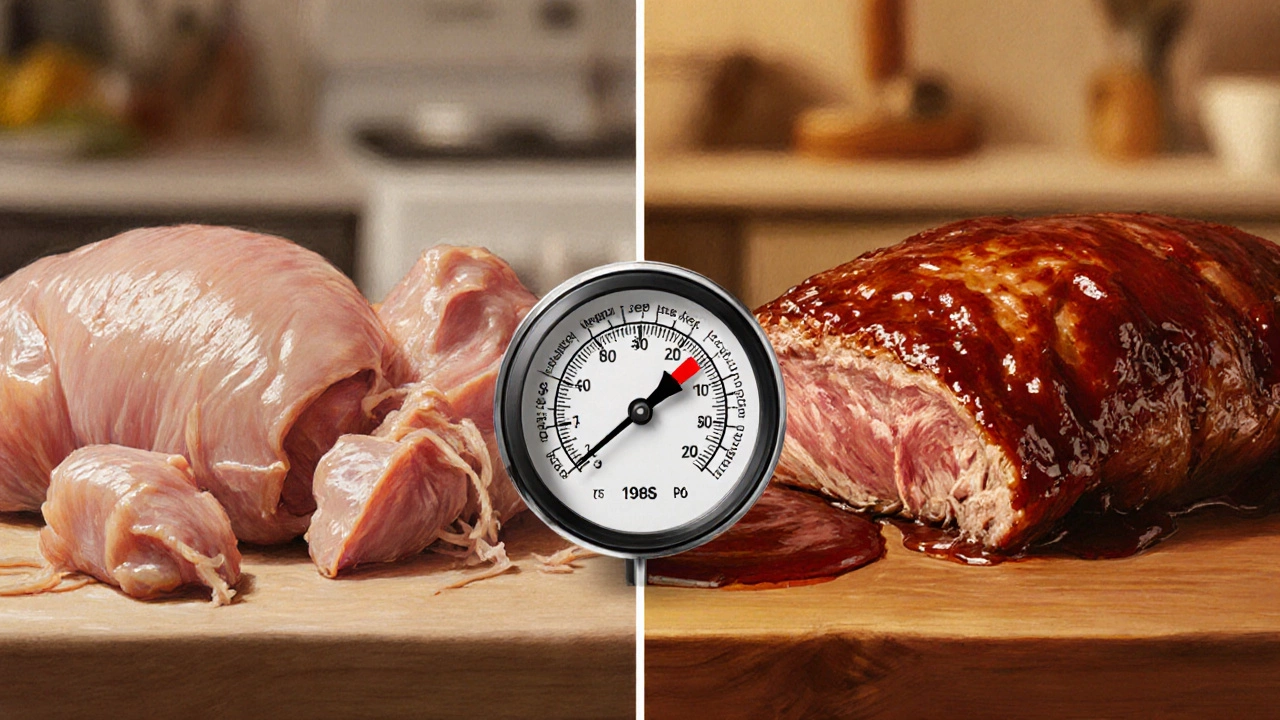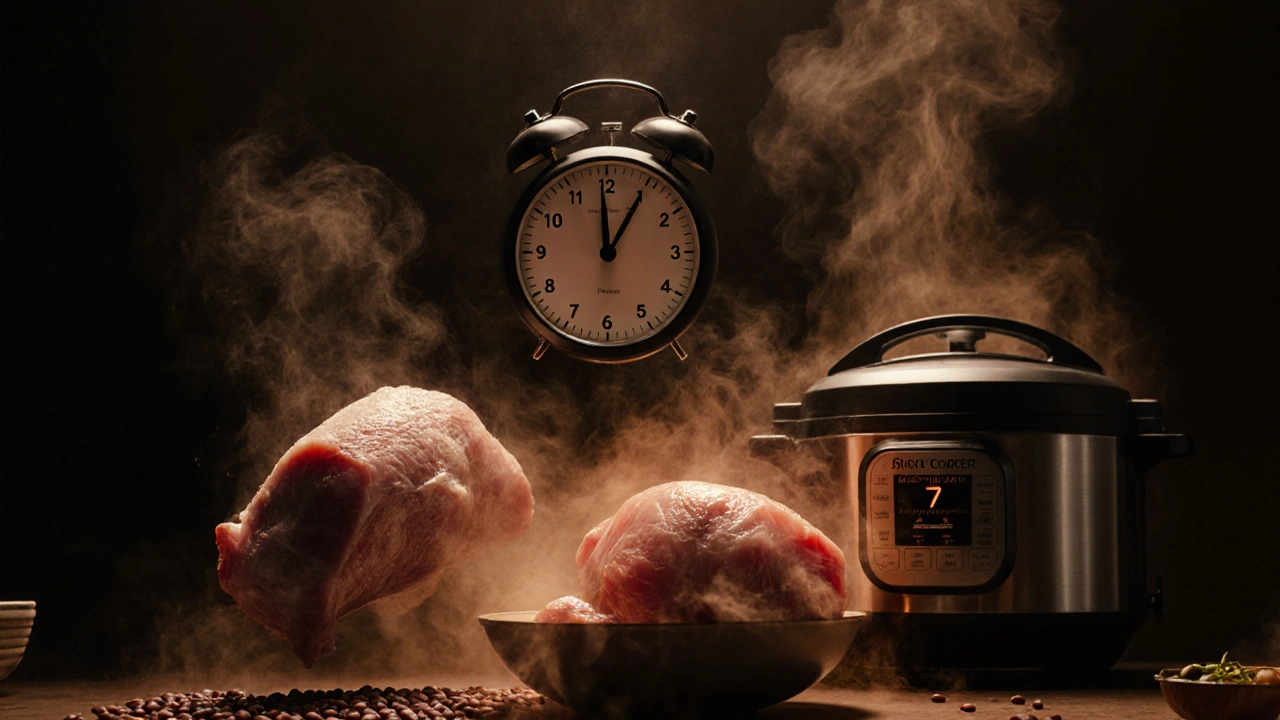Slow Cooker Time Calculator
Check if 3 Hours is Enough
Select your main ingredient to see if it can be safely cooked in 3 hours on high setting.
Results will appear here
Select an ingredient and click "Check Cooking Time" to see if 3 hours is sufficient.
You toss chicken, veggies, and a packet of seasoning into the slow cooker at 8 a.m., set it to high, and figure three hours is plenty-after all, it’s been on for half a workday. But when you get home, the chicken’s dry, the carrots are still crunchy, and the sauce tastes flat. What went wrong?
Three hours isn’t enough for most slow cooker meals
Most recipes call for 6 to 8 hours on low or 3 to 4 hours on high. That’s not a suggestion-it’s science. Slow cookers work by gently raising the temperature of food to between 170°F and 280°F. That’s low enough to avoid boiling, but high enough to slowly break down connective tissue, soften vegetables, and meld flavors. Three hours on high might sound like it should do the job, but it often doesn’t give meat enough time to become tender or for spices to fully infuse.
Take a beef stew, for example. Tough cuts like chuck roast contain collagen, a protein that turns into gelatin only after hours of low heat. At three hours, that collagen is barely starting to soften. The result? Chewy meat that feels like rubber. On six hours, it falls apart at the touch of a fork. Same goes for beans. Dried kidney beans need at least 7 hours on low to become safe to eat. Undercook them, and you risk solanine poisoning from unbroken toxins.
What actually cooks in 3 hours?
Not everything needs hours. Some dishes are built for speed. If you’re cooking something already tender-like boneless chicken breasts, fish fillets, or pre-cooked pasta-you can get away with 2 to 3 hours on high. A classic example is slow cooker honey garlic chicken thighs. With the right marinade and cut of meat, three hours gives you juicy, flavorful results without turning the chicken to sawdust.
Another win for short cook times: soups and broths made with pre-cooked ingredients. Try a quick chicken noodle soup using leftover rotisserie chicken, canned broth, and frozen vegetables. Three hours on high heats it through and blends the flavors without overcooking the noodles. Same goes for dips-like a three-ingredient slow cooker queso. Cheese melts, spices warm up, and it’s ready before your guests arrive.
Here’s a simple rule: if the main ingredient is already cooked or very tender, 3 hours on high is fine. If it’s raw, tough, or dense-like pork shoulder, beef brisket, or dried legumes-stick to 6+ hours.
High vs. low: what’s the difference?
Many people think high = faster cooking, low = slower cooking. That’s true, but it’s not the whole story. The difference isn’t just time-it’s temperature control. On high, the cooker reaches target temperature faster, but it also risks overcooking delicate items. On low, it creeps up slowly, giving food a gentle, even heat that preserves texture.
Here’s a real-world comparison: two batches of pulled pork. One cooked 3 hours on high. The other, 8 hours on low. The high batch? Dry, stringy, and slightly greasy. The low batch? Moist, shreddable, with a deep smoky flavor that clung to every fiber. That’s because low heat lets fat render slowly and moisture stay locked in. High heat forces moisture out before the collagen has time to dissolve.
Rule of thumb: if a recipe says 6-8 hours on low, don’t cut it to 3 on high. It won’t taste the same. If you’re short on time, use a pressure cooker instead. It mimics slow cooking in 30 minutes without sacrificing texture.

Why does timing matter for safety?
Food safety isn’t optional. The danger zone-between 40°F and 140°F-is where bacteria like salmonella and E. coli multiply fast. Slow cookers are designed to get food out of that zone quickly and keep it there. But if you undercook, you’re playing Russian roulette.
According to the USDA, poultry must reach 165°F internally to be safe. A chicken breast cooked for only 3 hours on high might hit that temperature on the surface, but the center? It could still be at 120°F. That’s not just undercooked-it’s risky. The same goes for ground meats and pork. They need to hit 160°F and stay there long enough to kill pathogens.
Always use a meat thermometer. Don’t guess. Stick it into the thickest part of the meat, away from bone or fat. If it’s not at the right temp after 3 hours, keep cooking. No shortcuts.
What to do if you only have 3 hours
You’re stuck. The kids are hungry. The slow cooker’s been on for 2 hours, and you just realized you forgot to turn it on until noon. What now?
First, don’t panic. Here’s what actually works:
- Switch to high if it’s on low. That gets the internal temp up faster.
- Chop ingredients smaller. Smaller pieces cook faster and more evenly.
- Start with room-temperature ingredients. Cold meat or frozen veggies drag down the pot’s heat.
- Add liquids like broth or sauce. Water helps transfer heat more efficiently than dry ingredients.
- Use a lid. Even a small gap lets steam escape and slows cooking.
And if you’re still worried? Finish it under the broiler. Transfer the meat to a baking sheet, slather it with sauce, and broil for 5 minutes. That gives you a caramelized crust and kills any lingering surface bacteria.
Common mistakes that ruin 3-hour slow cooker meals
People think slow cookers are foolproof. They’re not. Here’s what messes up short-cook recipes:
- Opening the lid too often. Every time you lift it, you lose 15-20 minutes of cooking time. Resist the urge to peek.
- Adding dairy too early. Milk, cream, and yogurt curdle if cooked too long. Add them in the last 30 minutes.
- Using frozen meat without adjusting time. Frozen chicken or beef can add 1-2 extra hours to cook time. Thaw it first if you can.
- Overfilling the pot. Slow cookers work best when half to two-thirds full. Too full? Heat can’t circulate. Too empty? Food dries out.
- Skipping the sear. Browning meat before adding it gives flavor depth that 3 hours of steaming can’t fix.
One quick fix: if your meal tastes bland after 3 hours, stir in a splash of vinegar, lemon juice, or Worcestershire sauce. Acid brightens dull flavors fast.

When to skip the slow cooker entirely
If you only have 3 hours and need a full meal, ask yourself: is this the right tool? Some things just don’t belong in a slow cooker.
Don’t try to cook:
- Seafood (it turns to mush)
- Delicate greens like spinach or arugula (they turn to slime)
- Pasta (it absorbs all the liquid and turns gummy)
- Rice (it becomes glue)
Instead, use your stove or oven. A 30-minute sheet pan dinner with chicken, potatoes, and broccoli cooks faster and tastes better than a half-done slow cooker disaster.
Final verdict: Is 3 hours enough?
It depends. For tender proteins like chicken breasts, fish, or pre-cooked meats-yes. For tougher cuts, beans, or stews-no. Three hours is the bare minimum for safety, not the sweet spot for flavor.
Here’s your cheat sheet:
| Ingredient | 3 Hours on High? (Yes/No) | Why |
|---|---|---|
| Chicken breasts | Yes | Tender, cooks fast, no collagen to break down |
| Pork shoulder | No | Needs 8+ hours to break down fat and connective tissue |
| Dried beans | No | Undercooked beans can cause food poisoning |
| Ground beef | Yes, if browned first | Small pieces cook quickly; searing adds flavor |
| Salmon fillets | Yes | Delicate, cooks fast. Add in last 1.5 hours |
| Carrots and potatoes | Maybe | Chop small, add early. Still may be firm after 3 hours |
If you’re unsure, wait. A 6-hour meal tastes better. A 3-hour meal might make you sick. Choose wisely.
What to try next
Try this 3-hour recipe: Slow Cooker Honey Garlic Chicken Thighs. Bone-in, skin-on thighs. 1/4 cup honey, 3 minced garlic cloves, 2 tbsp soy sauce, 1 tsp smoked paprika. Cook on high for 3 hours. Remove skin before serving. Juicy, sticky, and ready when you walk in the door.
Or, if you’ve got more time, try a 7-hour beef and barley stew. It’s the kind of meal that fills the whole house with warmth-and tastes like it took all day. Because it did.

